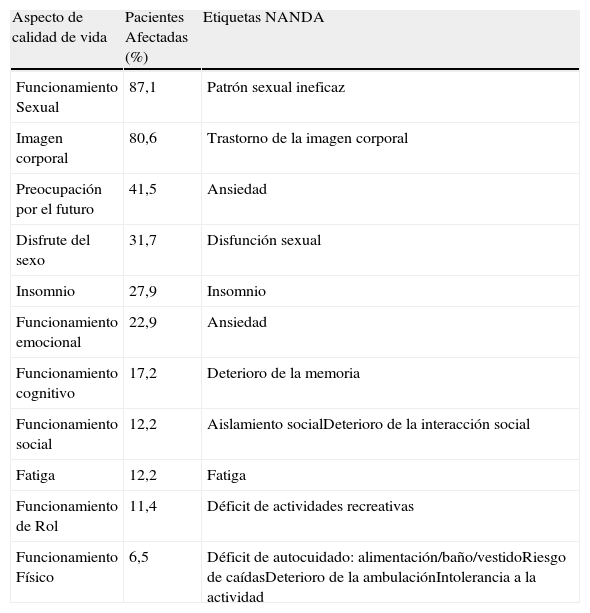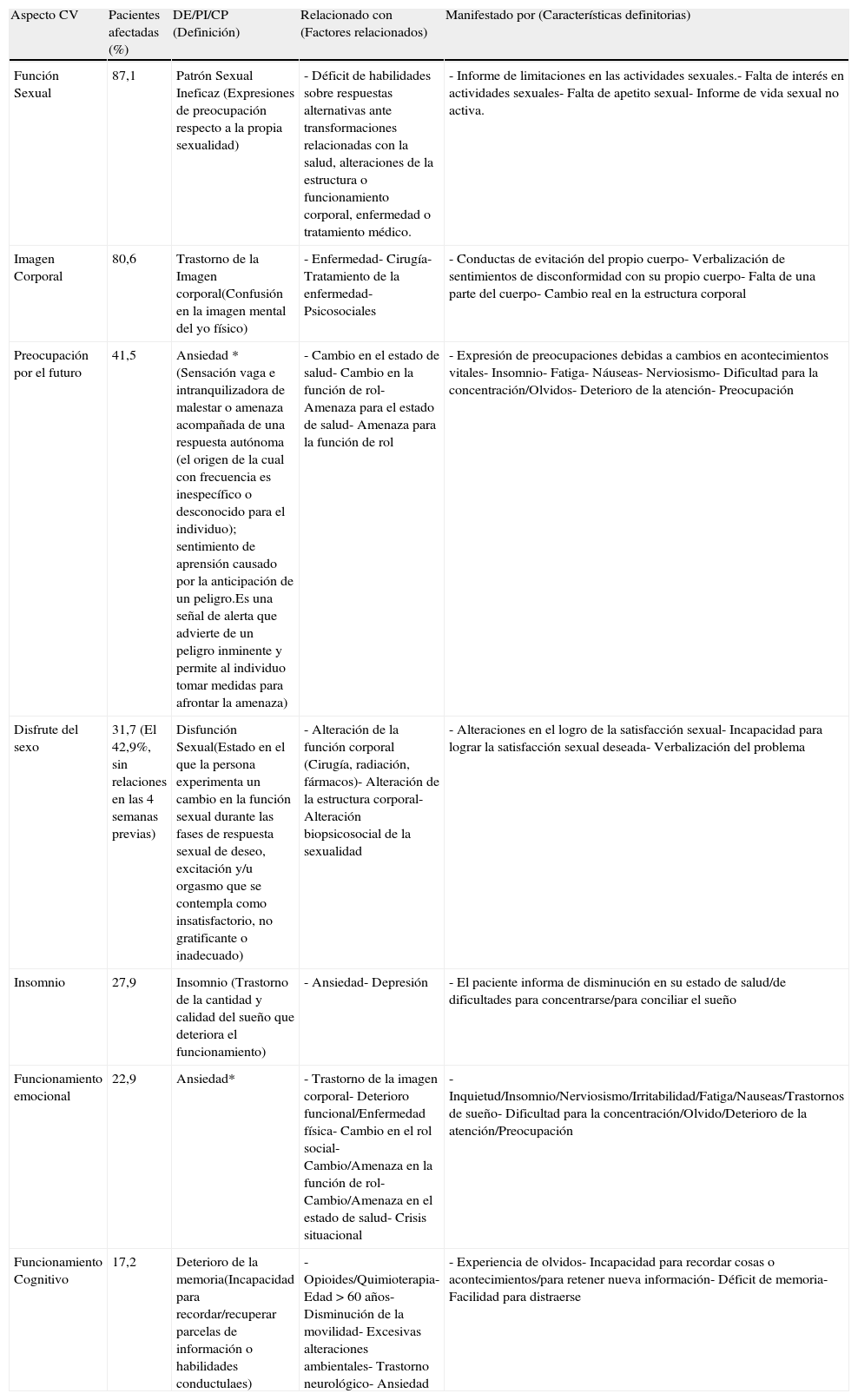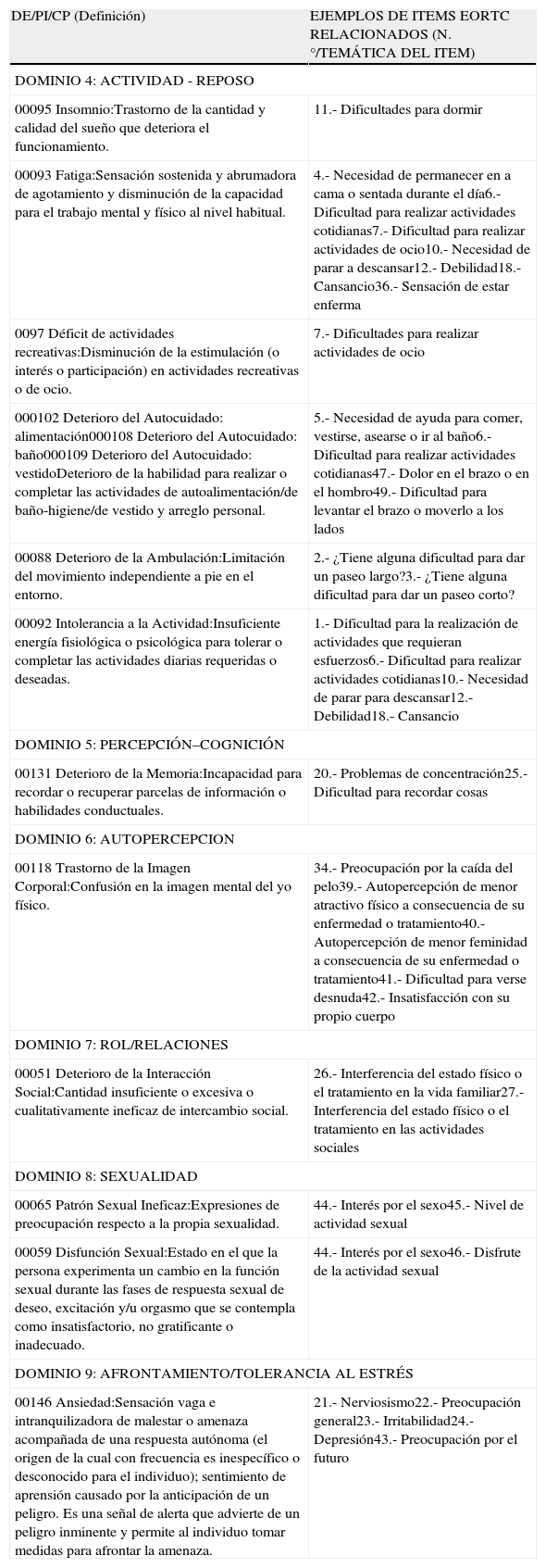El conocimiento de la calidad de vida (CV) de las pacientes supervivientes de cáncer de mama a través de una herramienta eficaz es primordial para identificar sus necesidades y problemas de salud. Adaptarlos al lenguaje enfermero a través de la taxonomía NANDA resulta fundamental.
ObjetivosEvaluar la CV de mujeres con diagnóstico de cáncer de mama en 2004 (supervivientes); Identificar sus problemas de salud más comunes, adaptándolos a la taxonomía NANDA.
Metodologíaestudio transversal descriptivo. Encuesta de CV (EORTC QLQ-C30 y BR23) en supervivientes de cáncer de mama y recogida de datos sociodemográficos y clínicos (octubre-diciembre, 2009). Estadística descriptiva (SPSS 18.0) y análisis de respuestas a los ítems del cuestionario, identificando características definitorias, factores relacionados y diagnósticos reales/potenciales (taxonomía NANDA).
Resultados140 participantes. Afectación importante en: Funcionamiento (F) sexual (23,16±25,85), Disfrute sexual (48,3±29,15), Preocupación por futuro (51,63±32,32), Insomnio (33,03±33,91) y Preocupación por pérdida de cabello (32,67±33,67). Problemas de salud más prevalentes: Patrón sexual ineficaz (87,1%), Trastorno Imagen Corporal (80,7%), Ansiedad (41,5) y Disfunción sexual (31,7%). Se muestra la correspondencia entre estos, las características definitorias-factores relacionados e ítems del cuestionario claves para su identificación.
DiscusiónLa CV de las supervivientes de cáncer de mama se ve afectada en diversos ámbitos. La escala EORTC puede utilizarse como una valoración focalizada sobre su CV. Se aportan evidencias sobre los diagnósticos más prevalentes en las supervivientes y constituye un primer paso hacia la normalización de los cuidados. La investigación sobre intervenciones enfermeras encaminadas a mejorar la CV de nuestras pacientes resulta necesaria.
Knowledge of the Quality of Life (QoL) of surviving patients with breast cancer using an effective tool, and adapting it to nursing language using NANDA taxonomy, is essential to identify their needs and health problems.
ObjectivesTo evaluate the QoL of women diagnosed with breast cancer in 2004 (survivors). To identify the most common health problems, and adapting them to the NANDA taxonomy.
MethodologyA cross-sectional descriptive study was conducted using a QoL Survey (EORTC QLQ-C30 and BR23) in breast cancer survivors with the collection of demographic and clinical data (October-December 2009). Descriptive statistics (SPSS 18.0) were performed, as well as an analysis of the responses to questionnaire items, identifying defining characteristics, related factors and actual/potential diagnoses (NANDA taxonomy).
ResultsThe study included 140 participants. There was a significant effect on: Sexual Function (23.16±25.85), Sexual Enjoyment (48.3±29.15), Concern for the future (51.63±32.32), insomnia (33.03±33.91) and Concern for hair loss (32.67±33.67). The most prevalent health problems were: inefficient sexual pattern (87.1%), body image disorder (80.7%), anxiety (41.5) and sexual dysfunction (31.7%). The relationship between these, the defining characteristics, the related factors and key questionnaire items for their identification are shown.
DiscussionThe QoL of breast cancer survivors is affected in various fields. The EORTC scale can be used as a focused evaluation of QoL. Evidence is provided on the most prevalent diagnoses in survivors, being a first step towards standardisation of care. Research on nursing interventions aimed at improving the QOL of patients is necessary.
Artículo
Comprando el artículo el PDF del mismo podrá ser descargado
Precio 19,34 €
Comprar ahora












